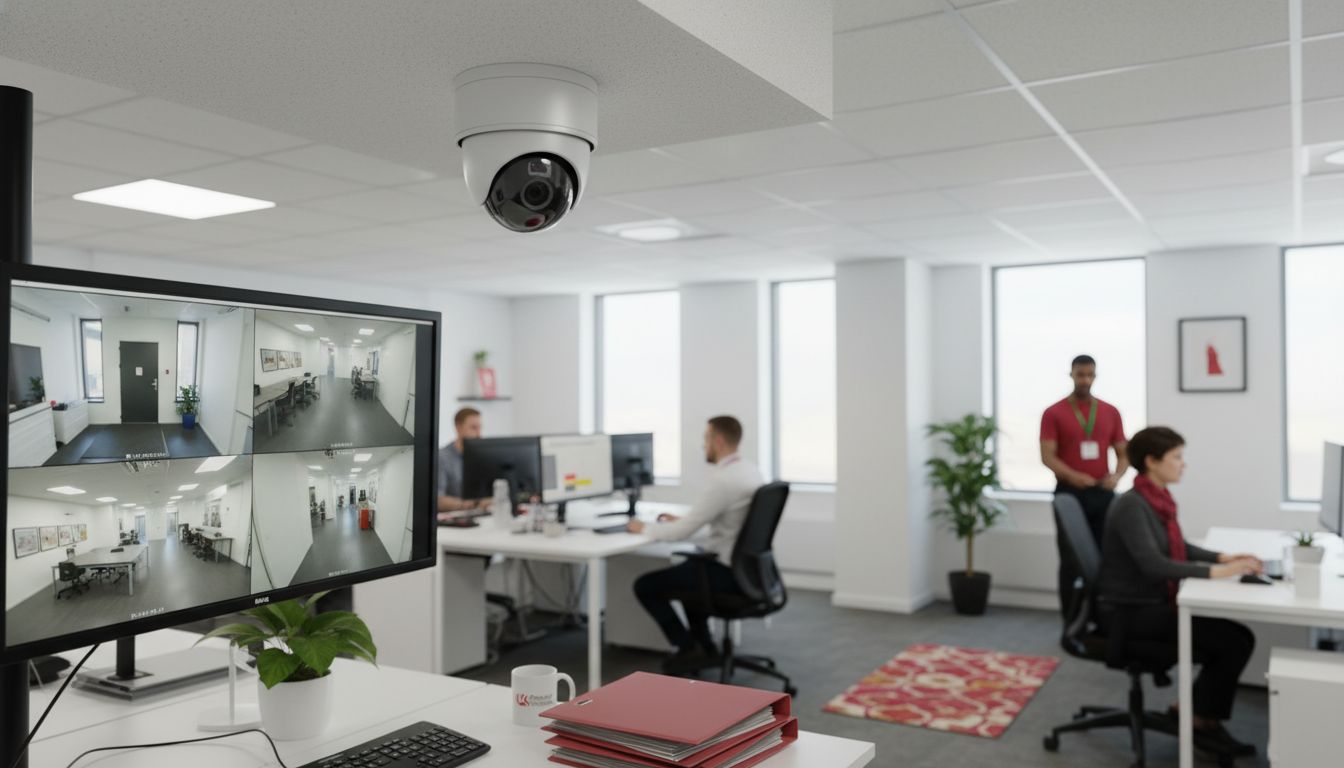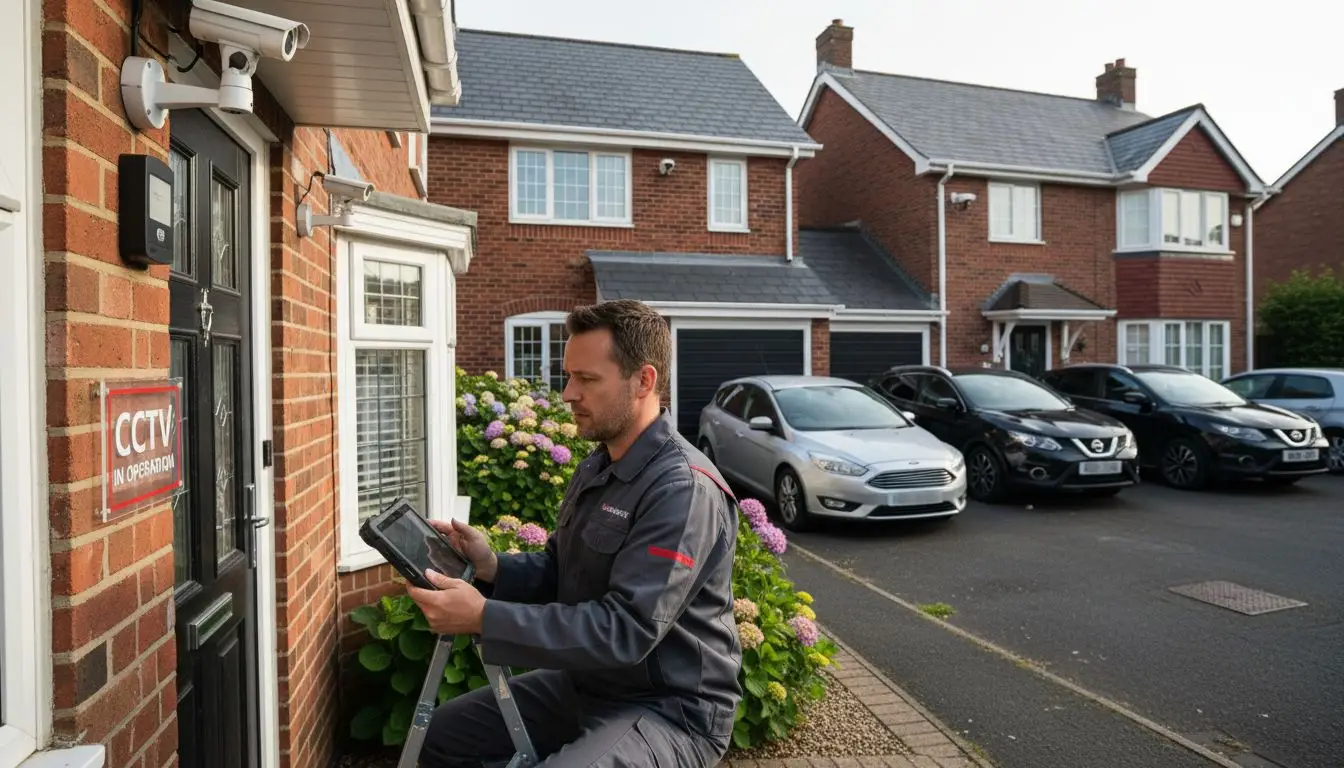Nearly every corner of the UK is now watched by CCTV, with an estimated four to six million cameras operating across the country. Security is a growing concern for both homeowners and businesses, making it more important than ever to understand how surveillance technology actually works. This article unpacks what CCTV is, explains its main types, and reveals how these systems provide real protection while staying within the law.
Key Takeaways
| Point | Details |
|---|---|
| CCTV as a Security Tool | CCTV systems monitor and record activities to deter crime, provide evidence, and enhance public safety in both private and public spaces. |
| Types of CCTV Systems | Options include wired, wireless, IP, and hybrid systems, each catering to different installation needs and environments. |
| Legal Compliance | UK CCTV users must follow strict data protection laws, including signage and limits on recording areas, to ensure responsible surveillance. |
| Best Practices | Proper camera positioning, regular maintenance, and robust cybersecurity are essential for maximizing the effectiveness and compliance of CCTV systems. |
What CCTV Is And How It Protects
Closed-circuit television (CCTV) is a sophisticated security technology designed to monitor and record activities in specific areas. According to nidirect, CCTV systems record images in public and private spaces to prevent and detect crime, maintain public order, and provide critical evidence for law enforcement.
Video surveillance works by capturing visual information through strategically placed cameras connected to a central monitoring system. These cameras can be fixed or movable, allowing comprehensive coverage of homes, businesses, and public spaces. Unlike broadcast television, CCTV transmits signals to specific monitors, ensuring the footage remains private and controlled.
The protective capabilities of CCTV extend far beyond simple recording. Modern systems offer real-time monitoring, motion detection, and even intelligent analytics that can identify unusual activities. By creating a visible deterrent and providing potential evidence, CCTV systems serve multiple protective functions:
- Prevent criminal activities through visible surveillance
- Provide detailed visual records of incidents
- Monitor high-risk or vulnerable areas

- Enable rapid response to potential security threats
- Support law enforcement investigations
For businesses and homeowners in the UK, investing in a robust CCTV system is no longer just an option but a critical security strategy. Essential Guide to CCTV Installation in the UK offers comprehensive insights into selecting the right security solution for your specific needs, ensuring comprehensive protection for your property.
Main Types Of CCTV Systems Explained
Video surveillance technology has evolved dramatically, offering multiple system types to suit diverse security needs. According to Wikipedia, technologies like HDcctv now provide advanced options for transmitting high-definition video, offering low latency and zero configuration advantages for modern security setups.
The primary CCTV system categories can be classified based on their technological approach and installation method. Wired CCTV systems use physical cable connections, providing stable and consistent video transmission with minimal signal interference. These systems are ideal for permanent installations in businesses and large properties where consistent power and connectivity are available.

Wireless CCTV systems offer more flexible installation options, allowing cameras to be placed in locations challenging for traditional wired setups. These systems transmit video signals through radio frequencies, enabling easier remote monitoring and quicker installation. Key variations include:
- IP Camera Systems: Digital networks transmitting video over internet protocols
- Analog Wireless Systems: Traditional signal transmission with limited range
- Hybrid Systems: Combining wired and wireless technologies for comprehensive coverage
Wired vs Wireless CCTV: Complete Installation Guide provides deeper insights into selecting the most appropriate system for your specific security requirements. Understanding these different CCTV types helps property owners make informed decisions about their security infrastructure.
Key Components And How CCTV Operates
CCTV systems are sophisticated security networks comprised of multiple essential components. According to Wikipedia, these systems fundamentally consist of cameras, monitors, and recording devices that transmit video signals to specific monitoring locations for comprehensive surveillance.
Camera Systems form the critical first layer of CCTV technology. These devices capture visual information and come in various types, including dome cameras, bullet cameras, and pan-tilt-zoom (PTZ) models. Each camera type offers unique advantages for different environmental and security requirements, such as wide-angle coverage or discrete monitoring.
Video Transmission and Storage involve complex technological processes. Modern systems convert visual information into digital signals, enabling remote monitoring and advanced data management. As noted by Wikipedia, contemporary CCTV setups now integrate video analytics and remote monitoring capabilities, allowing security personnel to respond to potential threats in real-time.
The core operational components of a CCTV system include:
- Cameras: Visual capture devices
- Cables/Wireless Transmitters: Signal transportation mechanisms
- Digital Video Recorders (DVRs): Data storage and processing units
- Monitors: Visual display interfaces
- Storage Systems: Local or cloud-based data retention
7 Essential CCTV Features List for Secure Properties provides deeper insights into selecting and understanding the most advanced security monitoring technologies available for modern properties.
Legal Requirements For CCTV Use In The UK
Navigating the legal landscape of CCTV installation requires careful understanding of privacy and data protection regulations. According to the Information Commissioner’s Office (ICO), homeowners and businesses must adhere to strict guidelines when implementing surveillance systems to ensure responsible and compliant use.
Data Protection Principles are fundamental to legal CCTV usage in the UK. The law mandates that any video surveillance must be proportionate, necessary, and minimally intrusive. This means property owners must have a legitimate reason for installing CCTV, such as security or safety, and cannot capture areas beyond their immediate property boundaries without explicit justification.
As outlined by UK Government guidelines, domestic and commercial CCTV users must comply with several key legal requirements:
- Inform people they are being recorded through clear signage
- Ensure cameras do not intrude on neighbours’ private spaces
- Limit recording to specific, justified purposes
- Protect and securely store recorded footage
- Provide access to recorded data if requested
- Comply with data protection registration requirements
CCTV Regulations in Essex: Essential Guide offers comprehensive insights into implementing CCTV systems while maintaining full legal compliance and respecting individual privacy rights.
Common Mistakes And Best Practice Tips
CCTV system implementation requires careful planning and strategic execution to ensure optimal security and legal compliance. Property owners often make critical errors that can compromise both the effectiveness of their surveillance and their legal standing.
Camera Positioning represents one of the most common mistake areas. Improperly placed cameras can create blind spots, violate privacy regulations, or fail to capture crucial areas. Best practices involve comprehensive site surveys, understanding potential threat locations, and ensuring cameras cover key entry points without unnecessarily intruding on neighbouring properties.
Technical configuration mistakes can significantly undermine CCTV system performance. Critical errors include inadequate storage capacity, poor image resolution, insufficient lighting considerations, and neglecting regular maintenance. Property owners should prioritize:
- Regular system diagnostics and maintenance checks
- Updating firmware and software consistently
- Implementing robust cybersecurity protocols
- Ensuring appropriate storage and backup strategies
- Conducting periodic review of camera angles and coverage
- Training personnel on proper system operation
6 Key CCTV System Features to Look For provides comprehensive guidance on selecting and maintaining advanced security monitoring technologies that help mitigate common implementation challenges.
Secure Your UK Property with Expert CCTV Solutions Today
Understanding how CCTV works is the first step towards protecting your home or business from security threats. If you are concerned about blind spots, camera placement, or complying with UK legal requirements, you are not alone. Many property owners struggle to choose the right system and install it properly to ensure both effective protection and privacy compliance. Our experts at 247 CCTV specialise in designing tailored CCTV systems that cover every angle you need while respecting legal guidelines.

Don’t leave your security to chance when the latest CCTV technology can provide real-time monitoring, clear video evidence, and peace of mind. Whether you need guidance on wired or wireless CCTV, or want the best features to enhance your surveillance setup, explore our resources on wired vs wireless CCTV and learn about the essential features for secure properties. Take action now to secure your home or business with professionals who understand your unique security challenges. Visit 247 CCTV to get started with a bespoke CCTV installation designed to protect what matters most.
Frequently Asked Questions
What is CCTV and how does it work?
CCTV, or closed-circuit television, is a security technology that captures and records video footage in specific areas. It uses cameras connected to a central monitoring system to transmit visual information, either through wired or wireless signal transmission.
What are the main types of CCTV systems available?
The main types of CCTV systems include wired systems, which use physical cables for stable video transmission, and wireless systems, which transmit video signals via radio frequencies. Variations include IP camera systems, analog wireless systems, and hybrid systems that combine both wired and wireless technologies.
What are the essential components of a CCTV system?
A CCTV system generally comprises cameras, monitors, digital video recorders (DVRs), and storage systems. Cameras capture visual footage, monitors display the video feed, and DVRs store and manage the recorded data.
What legal requirements should I be aware of when installing CCTV?
When installing CCTV, it is important to comply with data protection laws, which require informing people that they are being recorded, ensuring cameras do not intrude on neighbors’ private spaces, and limiting recording to justified purposes. Property owners must also securely store footage and allow access to recorded data when requested.

